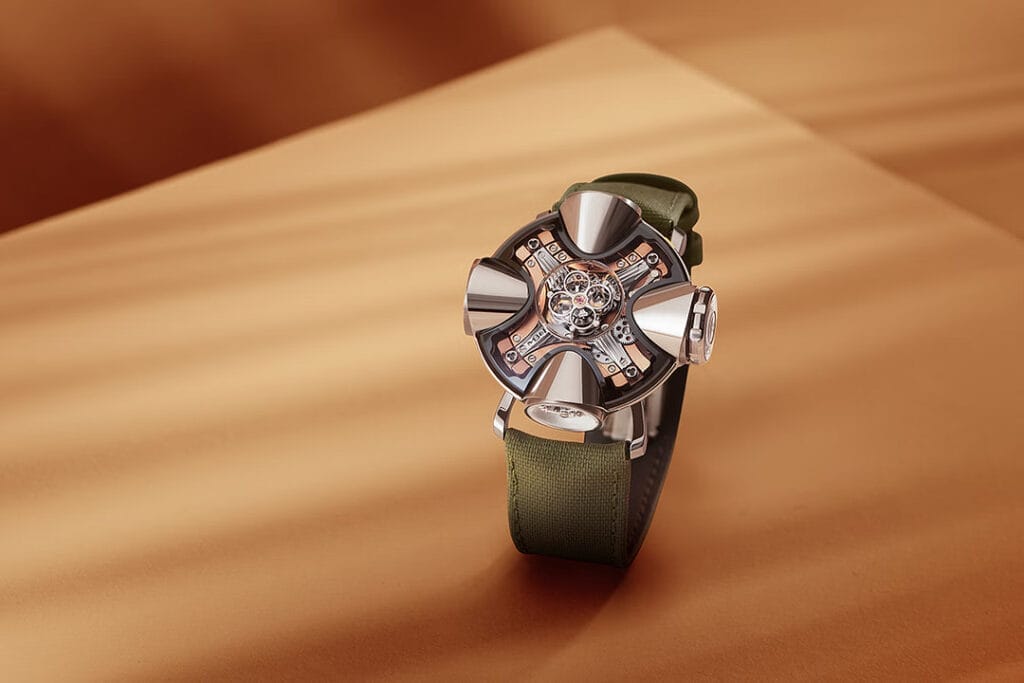by Lynette Koh

Photo: MB&F
Spaceships, cars, and even bulldogs and jellyfish: Max Busser of independent watch brand MB&F has been inspired by an impressive array of entities in creating his Horological Machines. For the brand’s latest HM11 Architect, Busser took his cues from a house.
And not any random home, of course. Those familiar with Busser’s love for retrofuturistic designs would not be surprised that the dwellings that captured his imagination were the rounded, organic houses of the ‘60s. They were designed with the concept of moulding space around its inhabitants, rather than forcing them into rectilinear confines.

MB&F HM11 Architect with blue dial plate. (Photo: MB&F)
Indeed, the HM11 looks like a mini model of one of those homes. Anchored by a central flying tourbillon — an MB&F signature also seen in the HM6 and HM7 — forming the centre of the house, four surrounding parabolic “rooms” feature different displays.
Measuring 42mm in diameter, the entire watch can be rotated so the wearer can view its different faces. Doubling down on this functionality, turning the house also winds the watch, with 10 complete rotations restoring the timepiece’s 96-hour power reserve. (Not to worry if you’re too lazy to do so regularly; the HM11 is self-winding.)

The time display of the MB&F HM11 Architect. (Photo: MB&F)
Each of the four room serves a different function. The main one, of course, is that for the time. Rod-mounted orbs serve as hour markers, with larger polished aluminium spheres representing the quarters, and darker and smaller titanium ones marking the rest. Red-tipped arrows indicate the hours and minutes.

MB&F HM11 Architect with red gold dial plate. (Photo: MB&F)
Echoing this design is the power reserve display, positioned 90 degrees to the left of the time room. Similar orbs of various sizes represent its power reserve, which is indicated by a red-tipped arrow. More likely to be found in a house than a watch, the third display is that of a thermometer. Using the traditional concept of a bimetallic strip, the thermometer of the HM11 measures temperatures between a range of -20 to 60 degrees Celsius.
The fourth room is distinguished by a badge engraved with MB&F’s battle-axe motif. Not immediately apparent, this module is actually the HM11’s time-setting crown, which can be pulled out with a click.

MB&F HM11 Architect worn on the wrist. (Photo: MB&F)
Taking almost a week to complete (we’re talking about all its processes including milling, finishing and quality control), the case is made from grade 5 titanium as well as sapphire crystal — most notably, the two discrete sapphire crystal domes that are stacked to form the central “skylight” covering the HM11’s flying tourbillon.
The HM11 comes in two variants, with their plates and bridges coloured using a PVD process. Limited to 25 pieces each, one features an ozone blue dial plate and the other, a red gold one. Once upon a time, we are told, Busser, gazing upon one of those organically sinuous homes built in the ‘60s, apparently mused, “What if that house was a watch?” With the HM11 Architect, we have the answer: It would be pretty darn cool.
The MB&F HM11 retails for $314,000.


